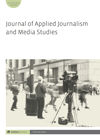
Full text loading...

 , Charlene Grace Lao1
, Charlene Grace Lao1 , Rushelle Intia1
, Rushelle Intia1 , Karol Ilagan1
, Karol Ilagan1 , Jeremaiah Opiniano1
, Jeremaiah Opiniano1
Memes have successfully disseminated various information on social media, albeit in a humorous tone. Journalism and journalists, however, remain uncertain in using memes as part of news work. Previous studies have revealed that variables related to journalism such as news values, participatory culture, public opinion, disinformation and credibility may be relevant in decisions to use memes in journalistic work. This survey from the Philippines employed partial least squares–structural equation modelling (PLS-SEM) to determine the factors that Filipino journalists (N = 138) consider in using political memes as a journalistic tool. This study is theoretically anchored on the theory of planned behaviour and the multilevel model of meme diffusion. It was found that the variables public opinion, news values, participatory culture and disinformation indirectly affect the production of political memes through mediation by intention. However, credibility was found to be insignificant. As well, results show that intention has a direct effect on the production of political memes. These results indicate that regardless of the degree of the variables’ existence, journalists still carry some intentions to produce political memes. Study results can provide reflections should journalists and their news organizations employ memes as a tool for credible news production, not as tools for disinformation.

Article metrics loading...

Full text loading...
References


Data & Media loading...
Publication Date:
https://doi.org/10.1386/ajms_00106_1 Published content will be available immediately after check-out or when it is released in case of a pre-order. Please make sure to be logged in to see all available purchase options.